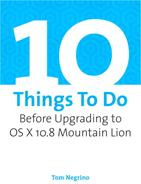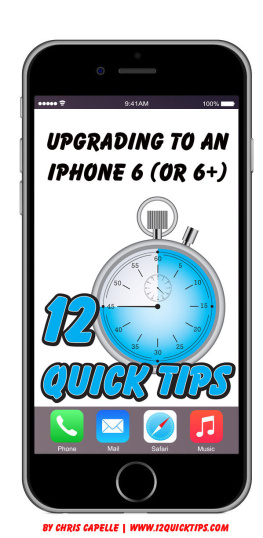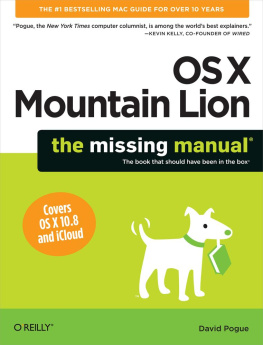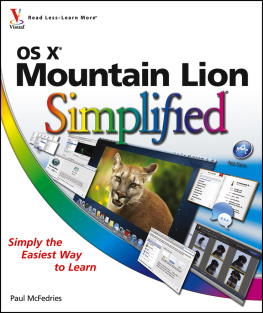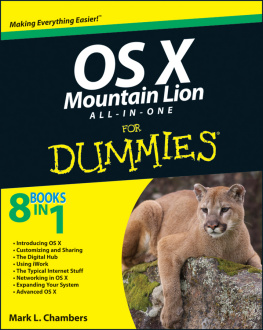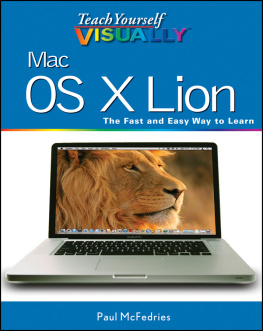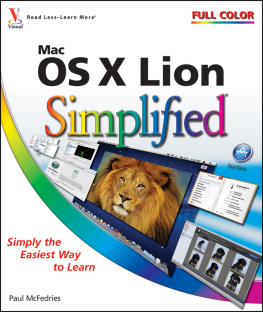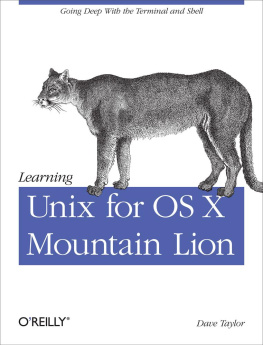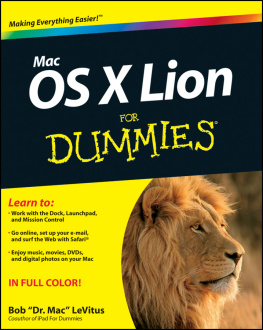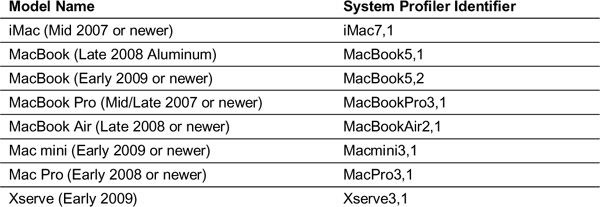10 Things To Do Before Upgrading to OS X 10.8 Mountain Lion
Tom Negrino
10 Things To Do Before Upgrading to OS X 10.8 Mountain Lion
Tom Negrino
Peachpit Press
1249 Eighth Street
Berkeley, CA 94710
510/524-2178
510/524-2221 (fax)
Find us on the Web at: www.peachpit.com
To report errors, please send a note to .
Peachpit Press is a division of Pearson Education.
Copyright 2013 by Tom Negrino
Editor: Clifford Colby
Notice of Rights
All rights reserved. No part of this book may be reproduced or transmitted in any form by any means, electronic, mechanical, photocopying, recording, or otherwise, without the prior written permission of the publisher. For information on getting permission for reprints and excerpts, contact
Notice of Liability
The information in this book is distributed on an As Is basis without warranty. While every precaution has been taken in the preparation of the book, neither the author nor Peachpit shall have any liability to any person or entity with respect to any loss or damage caused or alleged to be caused directly or indirectly by the instructions contained in this book or by the computer software and hardware products described in it.
Trademarks
AirPort, Aperture, Apple, Apple TV, iLife, iPad, iPhoto, iTunes, iWork, Mac, Macintosh, Mac OS, OS X, Rosetta, Safari, and Time Machine are trademarks of Apple Inc., registered in the U.S. and other countries.
Many of the designations used by manufacturers and sellers to distinguish their products are claimed as trademarks. Where those designations appear in this book, and Peachpit was aware of a trademark claim, the designations appear as requested by the owner of the trademark. All other product names and services identified throughout this book are used in editorial fashion only and for the benefit of such companies with no intention of infringement of the trademark. No such use, or the use of any trade name, is intended to convey endorsement or other affiliation with this book.
ISBN-13: 9780133157208
ISBN-10: 0133157202
9 8 7 6 5 4 3 2 1
Introduction
Its time once again for another big cat from Apple, and this time were moving to Mountain Lion, a.k.a. OS X 10.8 (did you notice that Apple has officially dropped the Mac from Mac OS X?). OS X 10.8 is a major system upgrade, and like all major upgrades, youll need to do some preparation before you make the jump. This ebook provides everything you need to know to get ready for your move to Mountain Lion.
Any big system upgrade requires you to learn the ins and outs of the new features in OS X, and that learning takes a bit of time. You could simply purchase the upgrade from the Mac App Store and click the Upgrade button, but I think its a much better idea to prepare your system so that after the upgrade, you can get back to work with the least amount of trouble and disruption. So Im going to walk you through the steps you should accomplish before clicking that fateful button. Youll evaluate your Mac and your apps, lay the groundwork for the upgrade, and learn how to protect your work in the rare event that something goes horribly wrong.
One thing I wont be doing in this book is discussing the process of whether or not you should be upgrading to Mountain Lion. I figure if youve bought this ebook, youve weighed the pros and cons of your situation, and already made the upgrade decision.
Ive been told by my editor that I forgot a key preparatory item when I wrote this guide, which Ill add here: make yourself a cup of coffee before you start this process (sorry, Im not a coffee drinker myself!). He assures me its an indispensable part of any system upgrade.
With that essential out of the way, lets get started preparing your Mac for OS X 10.8 Mountain Lion.
1. Confirm Hardware Compatibility
A good general rule of thumb with new major versions of OS X has been that they will support Macs made in the last four years. That was largely borne out with Tiger (Mac OS X 10.4), Leopard (Mac OS X 10.5), Snow Leopard (Mac OS X 10.6), and Lion (Mac OS X 10.7), with a few exceptions. Like those operating systems, Mountain Lion, released in late July 2012, supports many (but not every) Mac model made since 2008. Some models apparently didnt make the cut because their on-board graphics hardware wasnt up to the demands placed on it by Mountain Lion.
You can tell which Mac you have by two bits of information: its name and its Model Identifier. You can find the latter by holding down the Option key and choosing About This Mac from the Apple menu, which opens the System Profiler or System Information program (the name changed in Lion). The opening screen of this program shows you the Hardware Overview, with the Model Identifier listed ().
Oddly, System Profiler doesnt give you the models official Apple name (though Lions System Information does; choose Window > About This Mac, then click the Overview tab). To reliably match up the Model Identifier with the model name, I use the terrific Mactracker (; free from the Mac App Store), which has a comprehensive database of info about all Mac and iOS device models, as well as information about all versions of Apples system software and even peripherals.
According to Apple, your Mac must be one of the following models to install Mountain Lion:
Table 1. Mountain Lion Compatible Macs
The models listed in the table and later models are allowed to download and install Mountain Lion from the Mac App Store; as I write this, I dont yet know whether some other, earlier models will be able to use Mountain Lion when installed from media such as a USB thumb drive. For example, if a 2007 Mac Pro has an upgraded graphics card, will it be able to run Mountain Lion? Only experimentation by people who own those machines will tell.
We know for sure, however, that there are some not-very-old machines that are left out of the Mountain Lion party. MacBooks with plastic bodies from 2008 and the first model of the MacBook Air will end their careers running no version of OS X later than Lion.
Mountain Lion also includes some features that require newer hardware than is available in the compatibility list above. For example, the Power Nap feature, which updates many applications and system services while the Mac is sleeping, requires a Mac notebook with flash storage, such as newer MacBook Airs and the MacBook Pro with Retina Display.
General Requirements
Besides being the right kind of Mac, your machine should also meet some other basic hardware requirements (as well as having access to a fast Internet connection, because Mountain Lion is only available through the Mac App Store):
Available Disk Space: Apple says that you only need 8 GB of available disk space (roughly twice the size of the 4 GB Mountain Lion installer program), but realistically you should have much more. 20 to 25 GB of space makes good sense to me, because youll need it to install Mountain Lion, and for room for application upgrades (more on those later). Of course, youll also need plenty of space for your own data, because your music, pictures, and other documents take up a lot of space.

